Brand Equity Management Strategies PDF
VerifiedAdded on 2021/02/21
|16
|5430
|20
AI Summary
Contribute Materials
Your contribution can guide someone’s learning journey. Share your
documents today.
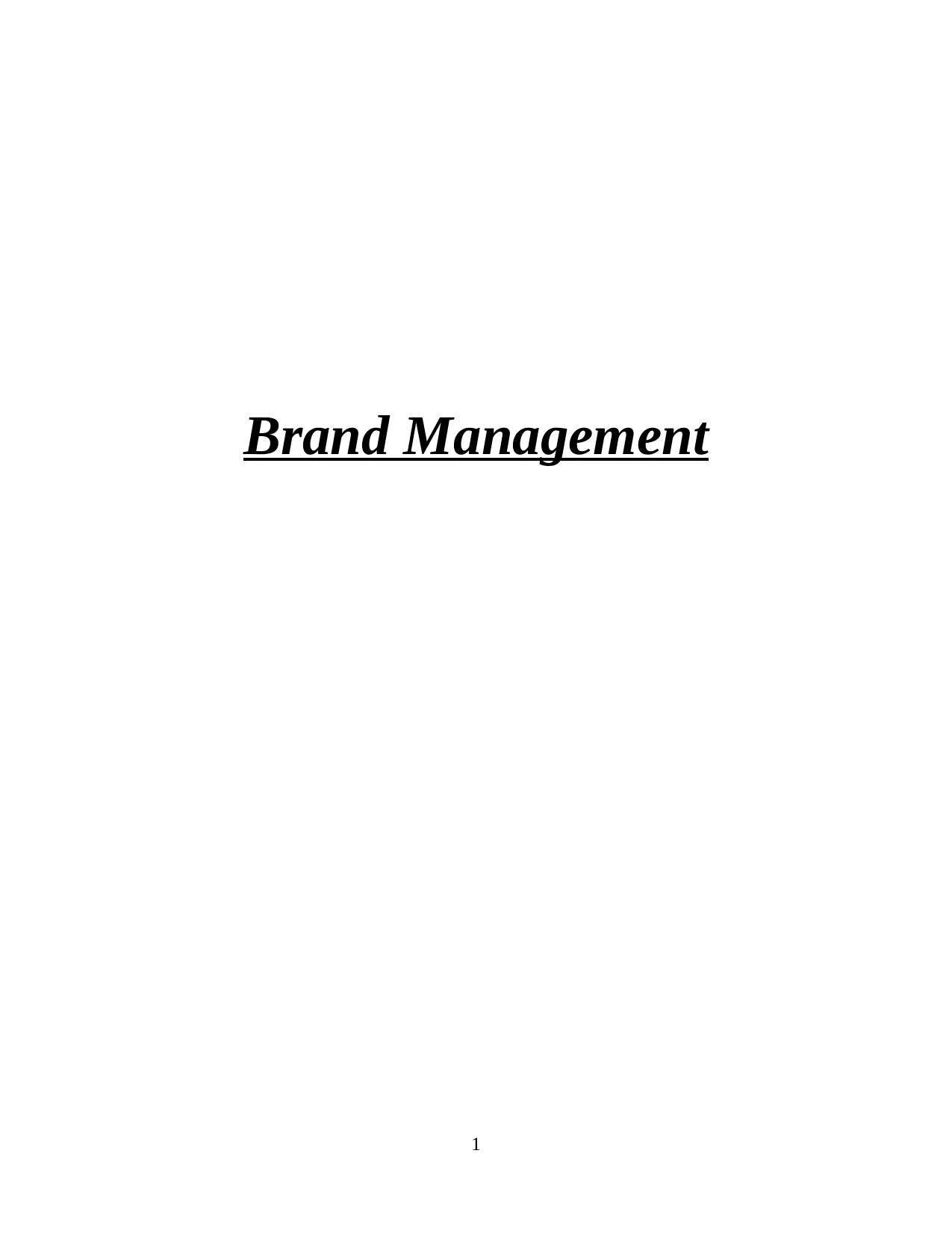
Brand Management
1
1
Secure Best Marks with AI Grader
Need help grading? Try our AI Grader for instant feedback on your assignments.
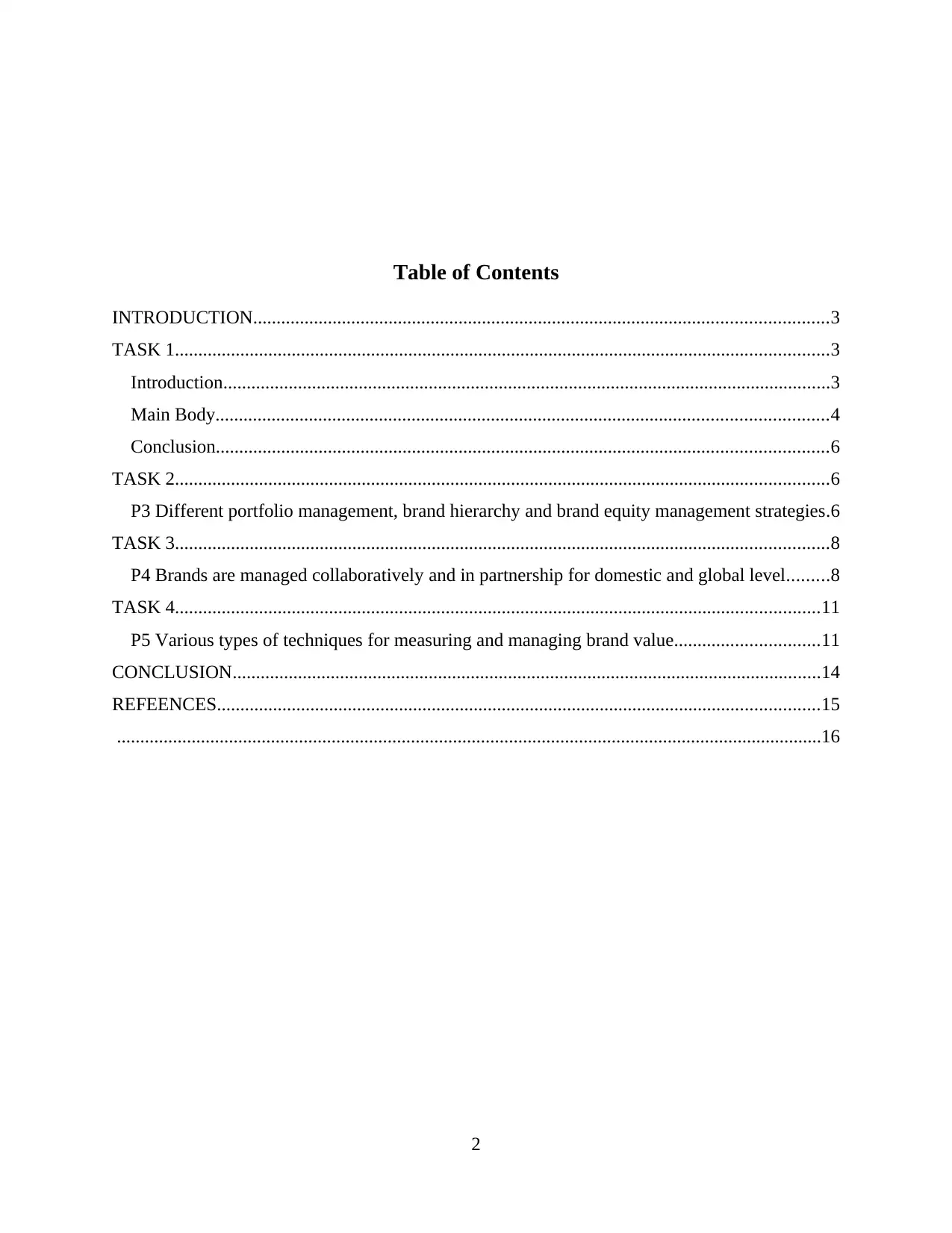
Table of Contents
INTRODUCTION...........................................................................................................................3
TASK 1............................................................................................................................................3
Introduction..................................................................................................................................3
Main Body...................................................................................................................................4
Conclusion...................................................................................................................................6
TASK 2............................................................................................................................................6
P3 Different portfolio management, brand hierarchy and brand equity management strategies.6
TASK 3............................................................................................................................................8
P4 Brands are managed collaboratively and in partnership for domestic and global level.........8
TASK 4..........................................................................................................................................11
P5 Various types of techniques for measuring and managing brand value...............................11
CONCLUSION..............................................................................................................................14
REFEENCES.................................................................................................................................15
.......................................................................................................................................................16
2
INTRODUCTION...........................................................................................................................3
TASK 1............................................................................................................................................3
Introduction..................................................................................................................................3
Main Body...................................................................................................................................4
Conclusion...................................................................................................................................6
TASK 2............................................................................................................................................6
P3 Different portfolio management, brand hierarchy and brand equity management strategies.6
TASK 3............................................................................................................................................8
P4 Brands are managed collaboratively and in partnership for domestic and global level.........8
TASK 4..........................................................................................................................................11
P5 Various types of techniques for measuring and managing brand value...............................11
CONCLUSION..............................................................................................................................14
REFEENCES.................................................................................................................................15
.......................................................................................................................................................16
2
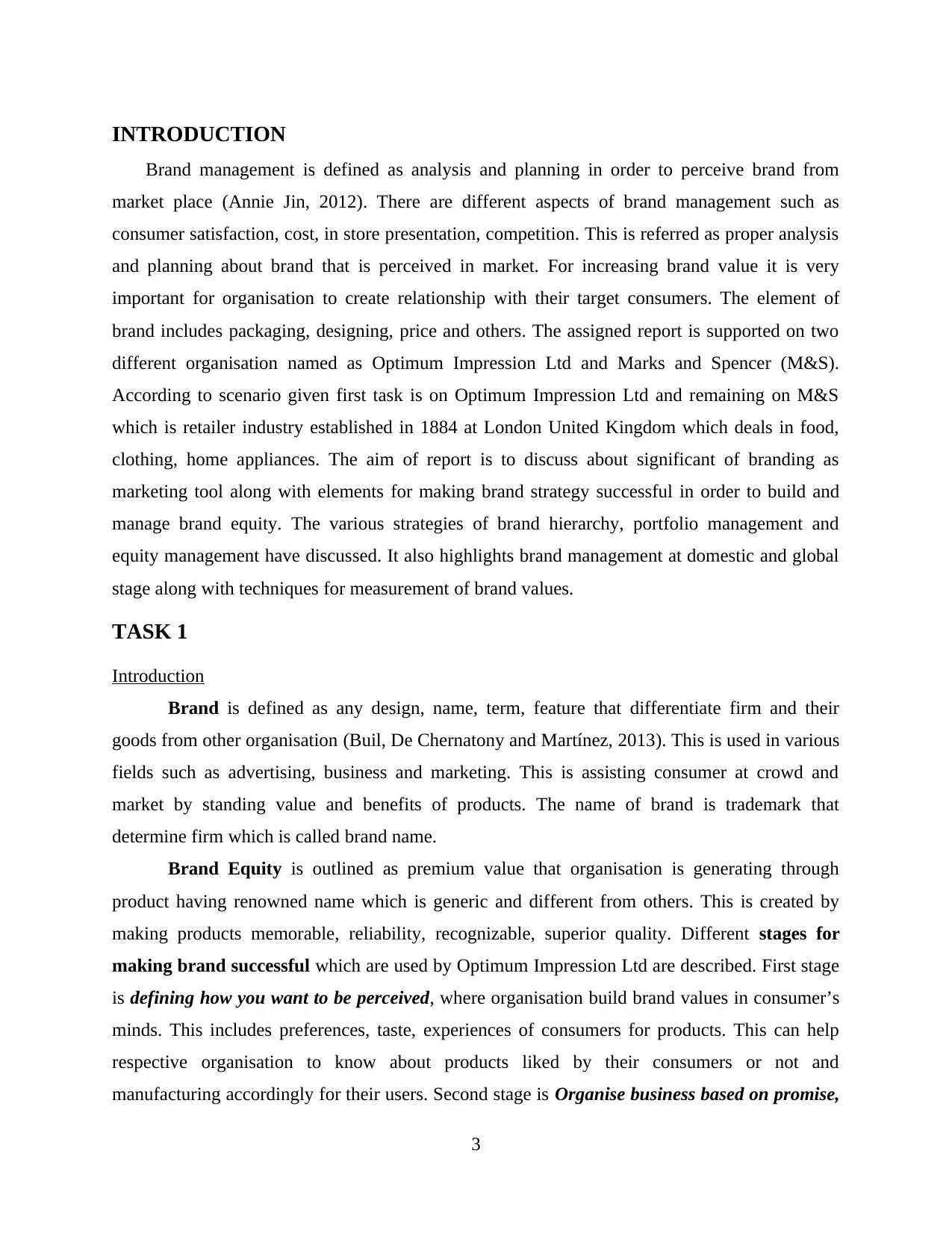
INTRODUCTION
Brand management is defined as analysis and planning in order to perceive brand from
market place (Annie Jin, 2012). There are different aspects of brand management such as
consumer satisfaction, cost, in store presentation, competition. This is referred as proper analysis
and planning about brand that is perceived in market. For increasing brand value it is very
important for organisation to create relationship with their target consumers. The element of
brand includes packaging, designing, price and others. The assigned report is supported on two
different organisation named as Optimum Impression Ltd and Marks and Spencer (M&S).
According to scenario given first task is on Optimum Impression Ltd and remaining on M&S
which is retailer industry established in 1884 at London United Kingdom which deals in food,
clothing, home appliances. The aim of report is to discuss about significant of branding as
marketing tool along with elements for making brand strategy successful in order to build and
manage brand equity. The various strategies of brand hierarchy, portfolio management and
equity management have discussed. It also highlights brand management at domestic and global
stage along with techniques for measurement of brand values.
TASK 1
Introduction
Brand is defined as any design, name, term, feature that differentiate firm and their
goods from other organisation (Buil, De Chernatony and Martínez, 2013). This is used in various
fields such as advertising, business and marketing. This is assisting consumer at crowd and
market by standing value and benefits of products. The name of brand is trademark that
determine firm which is called brand name.
Brand Equity is outlined as premium value that organisation is generating through
product having renowned name which is generic and different from others. This is created by
making products memorable, reliability, recognizable, superior quality. Different stages for
making brand successful which are used by Optimum Impression Ltd are described. First stage
is defining how you want to be perceived, where organisation build brand values in consumer’s
minds. This includes preferences, taste, experiences of consumers for products. This can help
respective organisation to know about products liked by their consumers or not and
manufacturing accordingly for their users. Second stage is Organise business based on promise,
3
Brand management is defined as analysis and planning in order to perceive brand from
market place (Annie Jin, 2012). There are different aspects of brand management such as
consumer satisfaction, cost, in store presentation, competition. This is referred as proper analysis
and planning about brand that is perceived in market. For increasing brand value it is very
important for organisation to create relationship with their target consumers. The element of
brand includes packaging, designing, price and others. The assigned report is supported on two
different organisation named as Optimum Impression Ltd and Marks and Spencer (M&S).
According to scenario given first task is on Optimum Impression Ltd and remaining on M&S
which is retailer industry established in 1884 at London United Kingdom which deals in food,
clothing, home appliances. The aim of report is to discuss about significant of branding as
marketing tool along with elements for making brand strategy successful in order to build and
manage brand equity. The various strategies of brand hierarchy, portfolio management and
equity management have discussed. It also highlights brand management at domestic and global
stage along with techniques for measurement of brand values.
TASK 1
Introduction
Brand is defined as any design, name, term, feature that differentiate firm and their
goods from other organisation (Buil, De Chernatony and Martínez, 2013). This is used in various
fields such as advertising, business and marketing. This is assisting consumer at crowd and
market by standing value and benefits of products. The name of brand is trademark that
determine firm which is called brand name.
Brand Equity is outlined as premium value that organisation is generating through
product having renowned name which is generic and different from others. This is created by
making products memorable, reliability, recognizable, superior quality. Different stages for
making brand successful which are used by Optimum Impression Ltd are described. First stage
is defining how you want to be perceived, where organisation build brand values in consumer’s
minds. This includes preferences, taste, experiences of consumers for products. This can help
respective organisation to know about products liked by their consumers or not and
manufacturing accordingly for their users. Second stage is Organise business based on promise,
3
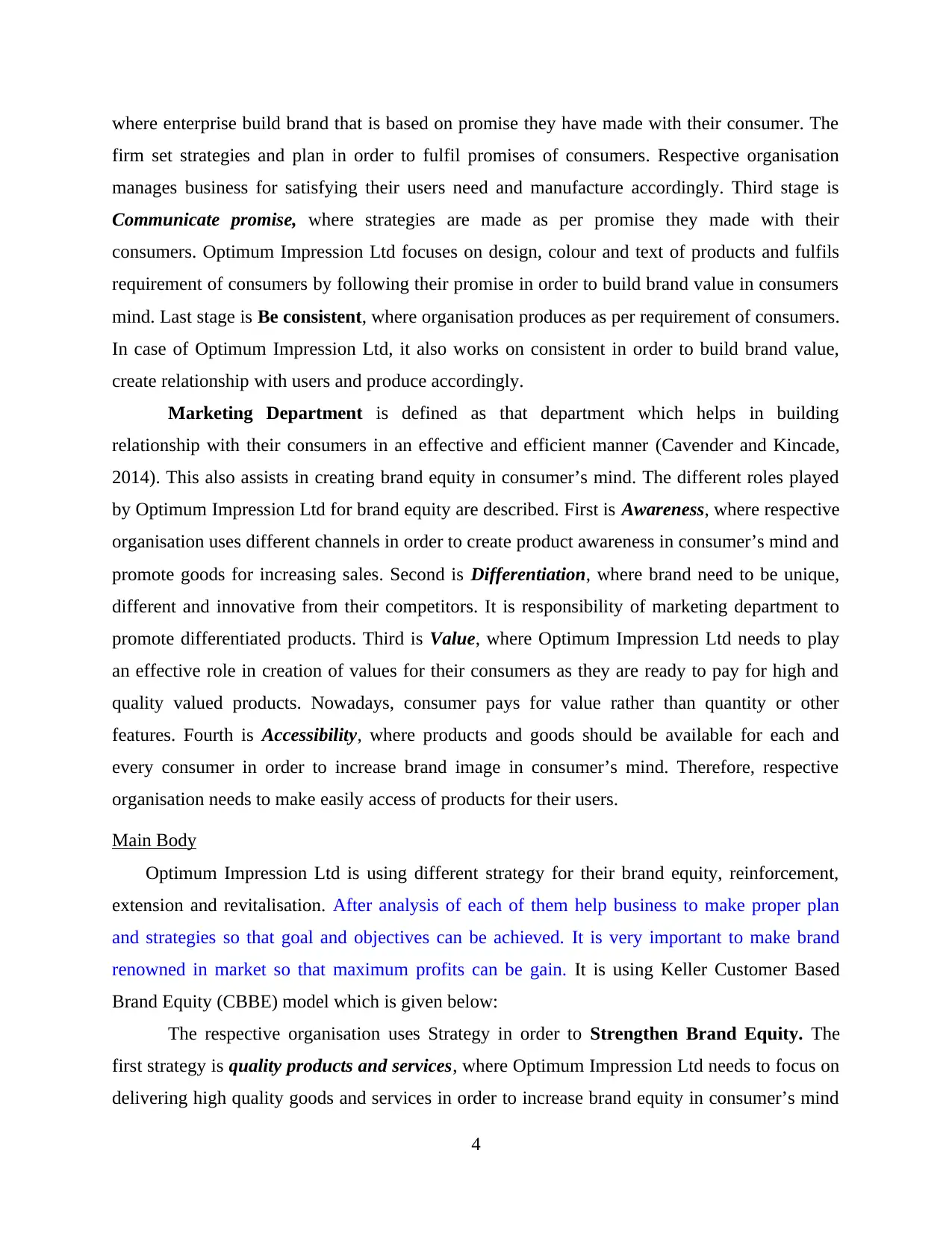
where enterprise build brand that is based on promise they have made with their consumer. The
firm set strategies and plan in order to fulfil promises of consumers. Respective organisation
manages business for satisfying their users need and manufacture accordingly. Third stage is
Communicate promise, where strategies are made as per promise they made with their
consumers. Optimum Impression Ltd focuses on design, colour and text of products and fulfils
requirement of consumers by following their promise in order to build brand value in consumers
mind. Last stage is Be consistent, where organisation produces as per requirement of consumers.
In case of Optimum Impression Ltd, it also works on consistent in order to build brand value,
create relationship with users and produce accordingly.
Marketing Department is defined as that department which helps in building
relationship with their consumers in an effective and efficient manner (Cavender and Kincade,
2014). This also assists in creating brand equity in consumer’s mind. The different roles played
by Optimum Impression Ltd for brand equity are described. First is Awareness, where respective
organisation uses different channels in order to create product awareness in consumer’s mind and
promote goods for increasing sales. Second is Differentiation, where brand need to be unique,
different and innovative from their competitors. It is responsibility of marketing department to
promote differentiated products. Third is Value, where Optimum Impression Ltd needs to play
an effective role in creation of values for their consumers as they are ready to pay for high and
quality valued products. Nowadays, consumer pays for value rather than quantity or other
features. Fourth is Accessibility, where products and goods should be available for each and
every consumer in order to increase brand image in consumer’s mind. Therefore, respective
organisation needs to make easily access of products for their users.
Main Body
Optimum Impression Ltd is using different strategy for their brand equity, reinforcement,
extension and revitalisation. After analysis of each of them help business to make proper plan
and strategies so that goal and objectives can be achieved. It is very important to make brand
renowned in market so that maximum profits can be gain. It is using Keller Customer Based
Brand Equity (CBBE) model which is given below:
The respective organisation uses Strategy in order to Strengthen Brand Equity. The
first strategy is quality products and services, where Optimum Impression Ltd needs to focus on
delivering high quality goods and services in order to increase brand equity in consumer’s mind
4
firm set strategies and plan in order to fulfil promises of consumers. Respective organisation
manages business for satisfying their users need and manufacture accordingly. Third stage is
Communicate promise, where strategies are made as per promise they made with their
consumers. Optimum Impression Ltd focuses on design, colour and text of products and fulfils
requirement of consumers by following their promise in order to build brand value in consumers
mind. Last stage is Be consistent, where organisation produces as per requirement of consumers.
In case of Optimum Impression Ltd, it also works on consistent in order to build brand value,
create relationship with users and produce accordingly.
Marketing Department is defined as that department which helps in building
relationship with their consumers in an effective and efficient manner (Cavender and Kincade,
2014). This also assists in creating brand equity in consumer’s mind. The different roles played
by Optimum Impression Ltd for brand equity are described. First is Awareness, where respective
organisation uses different channels in order to create product awareness in consumer’s mind and
promote goods for increasing sales. Second is Differentiation, where brand need to be unique,
different and innovative from their competitors. It is responsibility of marketing department to
promote differentiated products. Third is Value, where Optimum Impression Ltd needs to play
an effective role in creation of values for their consumers as they are ready to pay for high and
quality valued products. Nowadays, consumer pays for value rather than quantity or other
features. Fourth is Accessibility, where products and goods should be available for each and
every consumer in order to increase brand image in consumer’s mind. Therefore, respective
organisation needs to make easily access of products for their users.
Main Body
Optimum Impression Ltd is using different strategy for their brand equity, reinforcement,
extension and revitalisation. After analysis of each of them help business to make proper plan
and strategies so that goal and objectives can be achieved. It is very important to make brand
renowned in market so that maximum profits can be gain. It is using Keller Customer Based
Brand Equity (CBBE) model which is given below:
The respective organisation uses Strategy in order to Strengthen Brand Equity. The
first strategy is quality products and services, where Optimum Impression Ltd needs to focus on
delivering high quality goods and services in order to increase brand equity in consumer’s mind
4
Secure Best Marks with AI Grader
Need help grading? Try our AI Grader for instant feedback on your assignments.
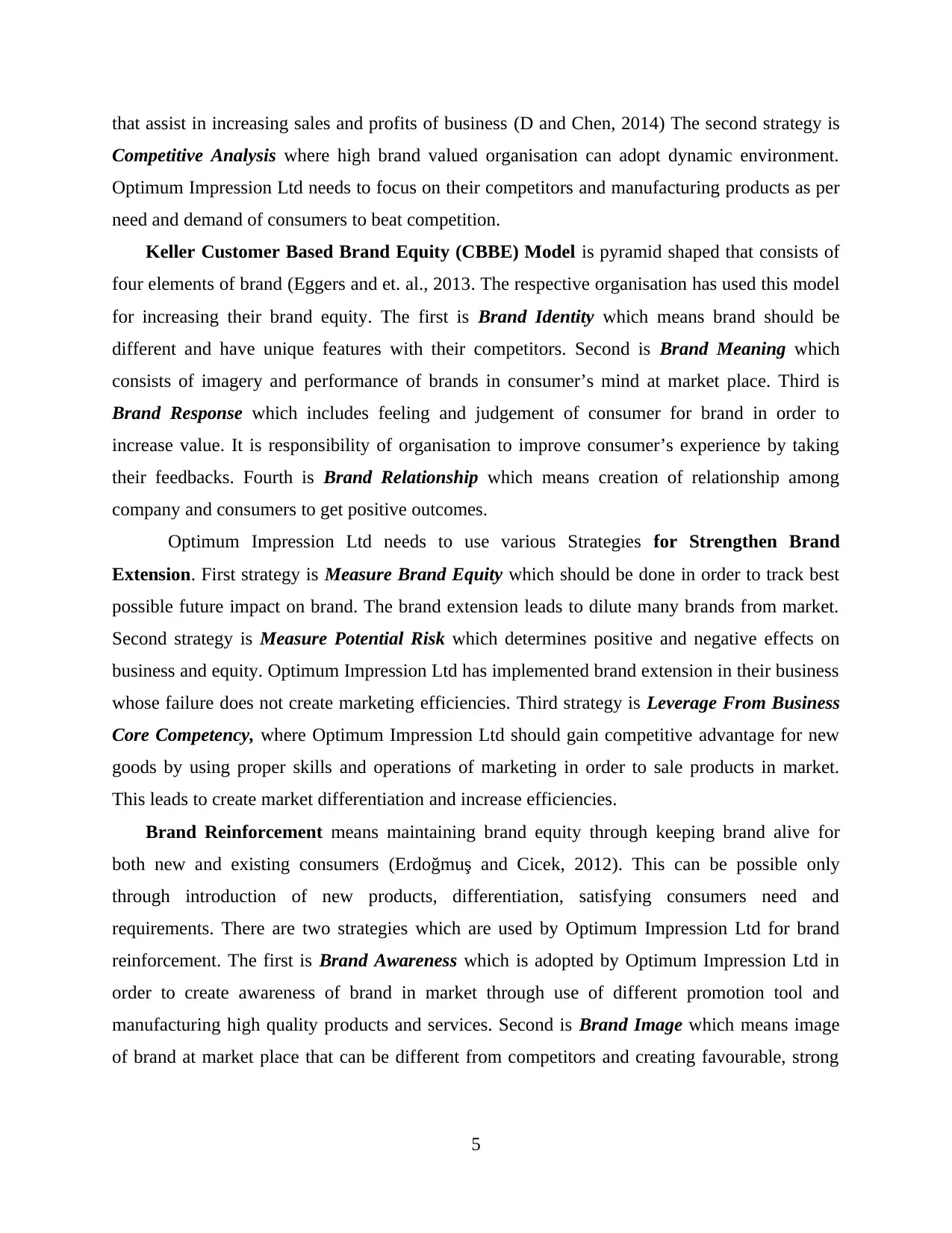
that assist in increasing sales and profits of business (D and Chen, 2014) The second strategy is
Competitive Analysis where high brand valued organisation can adopt dynamic environment.
Optimum Impression Ltd needs to focus on their competitors and manufacturing products as per
need and demand of consumers to beat competition.
Keller Customer Based Brand Equity (CBBE) Model is pyramid shaped that consists of
four elements of brand (Eggers and et. al., 2013. The respective organisation has used this model
for increasing their brand equity. The first is Brand Identity which means brand should be
different and have unique features with their competitors. Second is Brand Meaning which
consists of imagery and performance of brands in consumer’s mind at market place. Third is
Brand Response which includes feeling and judgement of consumer for brand in order to
increase value. It is responsibility of organisation to improve consumer’s experience by taking
their feedbacks. Fourth is Brand Relationship which means creation of relationship among
company and consumers to get positive outcomes.
Optimum Impression Ltd needs to use various Strategies for Strengthen Brand
Extension. First strategy is Measure Brand Equity which should be done in order to track best
possible future impact on brand. The brand extension leads to dilute many brands from market.
Second strategy is Measure Potential Risk which determines positive and negative effects on
business and equity. Optimum Impression Ltd has implemented brand extension in their business
whose failure does not create marketing efficiencies. Third strategy is Leverage From Business
Core Competency, where Optimum Impression Ltd should gain competitive advantage for new
goods by using proper skills and operations of marketing in order to sale products in market.
This leads to create market differentiation and increase efficiencies.
Brand Reinforcement means maintaining brand equity through keeping brand alive for
both new and existing consumers (Erdoğmuş and Cicek, 2012). This can be possible only
through introduction of new products, differentiation, satisfying consumers need and
requirements. There are two strategies which are used by Optimum Impression Ltd for brand
reinforcement. The first is Brand Awareness which is adopted by Optimum Impression Ltd in
order to create awareness of brand in market through use of different promotion tool and
manufacturing high quality products and services. Second is Brand Image which means image
of brand at market place that can be different from competitors and creating favourable, strong
5
Competitive Analysis where high brand valued organisation can adopt dynamic environment.
Optimum Impression Ltd needs to focus on their competitors and manufacturing products as per
need and demand of consumers to beat competition.
Keller Customer Based Brand Equity (CBBE) Model is pyramid shaped that consists of
four elements of brand (Eggers and et. al., 2013. The respective organisation has used this model
for increasing their brand equity. The first is Brand Identity which means brand should be
different and have unique features with their competitors. Second is Brand Meaning which
consists of imagery and performance of brands in consumer’s mind at market place. Third is
Brand Response which includes feeling and judgement of consumer for brand in order to
increase value. It is responsibility of organisation to improve consumer’s experience by taking
their feedbacks. Fourth is Brand Relationship which means creation of relationship among
company and consumers to get positive outcomes.
Optimum Impression Ltd needs to use various Strategies for Strengthen Brand
Extension. First strategy is Measure Brand Equity which should be done in order to track best
possible future impact on brand. The brand extension leads to dilute many brands from market.
Second strategy is Measure Potential Risk which determines positive and negative effects on
business and equity. Optimum Impression Ltd has implemented brand extension in their business
whose failure does not create marketing efficiencies. Third strategy is Leverage From Business
Core Competency, where Optimum Impression Ltd should gain competitive advantage for new
goods by using proper skills and operations of marketing in order to sale products in market.
This leads to create market differentiation and increase efficiencies.
Brand Reinforcement means maintaining brand equity through keeping brand alive for
both new and existing consumers (Erdoğmuş and Cicek, 2012). This can be possible only
through introduction of new products, differentiation, satisfying consumers need and
requirements. There are two strategies which are used by Optimum Impression Ltd for brand
reinforcement. The first is Brand Awareness which is adopted by Optimum Impression Ltd in
order to create awareness of brand in market through use of different promotion tool and
manufacturing high quality products and services. Second is Brand Image which means image
of brand at market place that can be different from competitors and creating favourable, strong
5
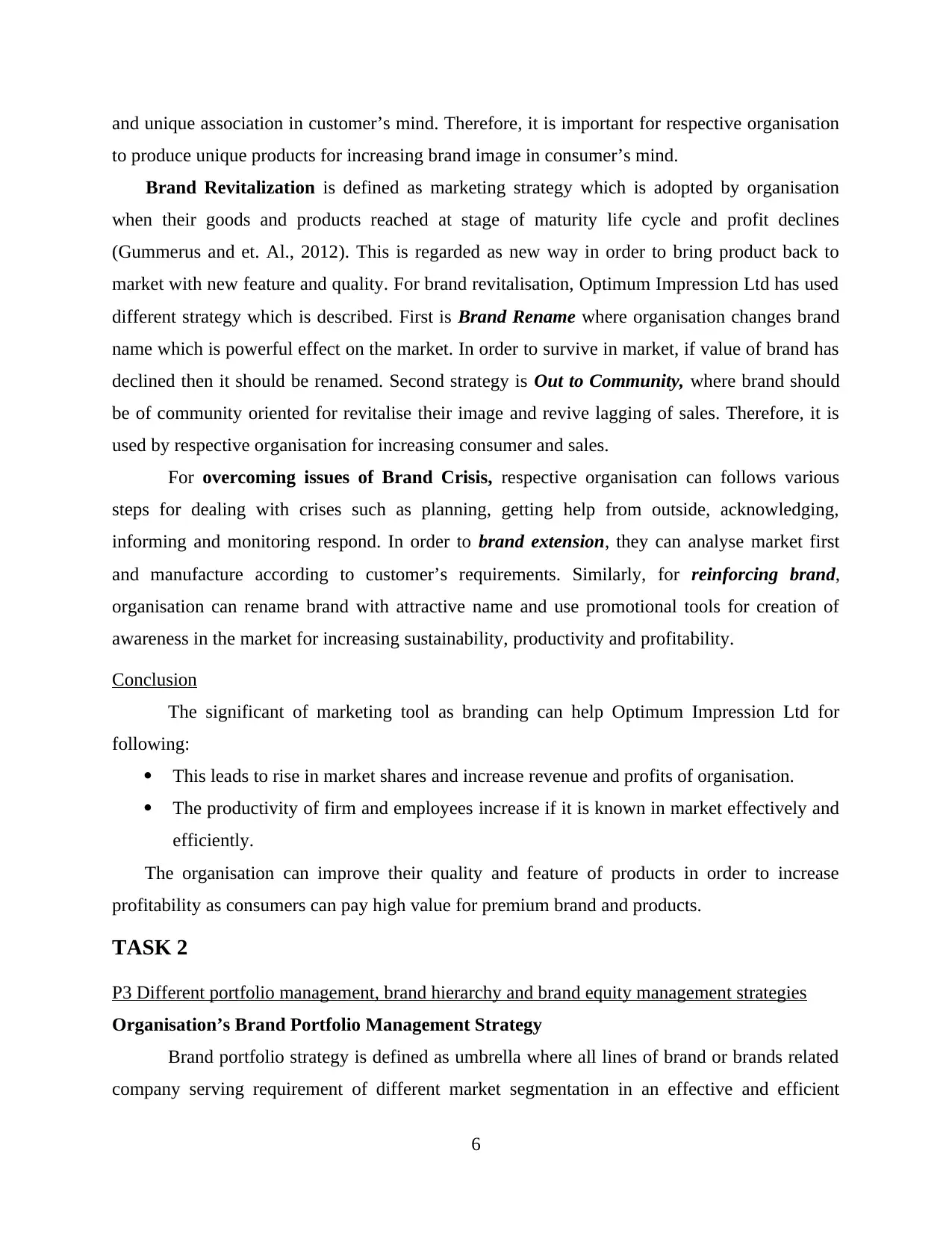
and unique association in customer’s mind. Therefore, it is important for respective organisation
to produce unique products for increasing brand image in consumer’s mind.
Brand Revitalization is defined as marketing strategy which is adopted by organisation
when their goods and products reached at stage of maturity life cycle and profit declines
(Gummerus and et. Al., 2012). This is regarded as new way in order to bring product back to
market with new feature and quality. For brand revitalisation, Optimum Impression Ltd has used
different strategy which is described. First is Brand Rename where organisation changes brand
name which is powerful effect on the market. In order to survive in market, if value of brand has
declined then it should be renamed. Second strategy is Out to Community, where brand should
be of community oriented for revitalise their image and revive lagging of sales. Therefore, it is
used by respective organisation for increasing consumer and sales.
For overcoming issues of Brand Crisis, respective organisation can follows various
steps for dealing with crises such as planning, getting help from outside, acknowledging,
informing and monitoring respond. In order to brand extension, they can analyse market first
and manufacture according to customer’s requirements. Similarly, for reinforcing brand,
organisation can rename brand with attractive name and use promotional tools for creation of
awareness in the market for increasing sustainability, productivity and profitability.
Conclusion
The significant of marketing tool as branding can help Optimum Impression Ltd for
following:
This leads to rise in market shares and increase revenue and profits of organisation.
The productivity of firm and employees increase if it is known in market effectively and
efficiently.
The organisation can improve their quality and feature of products in order to increase
profitability as consumers can pay high value for premium brand and products.
TASK 2
P3 Different portfolio management, brand hierarchy and brand equity management strategies
Organisation’s Brand Portfolio Management Strategy
Brand portfolio strategy is defined as umbrella where all lines of brand or brands related
company serving requirement of different market segmentation in an effective and efficient
6
to produce unique products for increasing brand image in consumer’s mind.
Brand Revitalization is defined as marketing strategy which is adopted by organisation
when their goods and products reached at stage of maturity life cycle and profit declines
(Gummerus and et. Al., 2012). This is regarded as new way in order to bring product back to
market with new feature and quality. For brand revitalisation, Optimum Impression Ltd has used
different strategy which is described. First is Brand Rename where organisation changes brand
name which is powerful effect on the market. In order to survive in market, if value of brand has
declined then it should be renamed. Second strategy is Out to Community, where brand should
be of community oriented for revitalise their image and revive lagging of sales. Therefore, it is
used by respective organisation for increasing consumer and sales.
For overcoming issues of Brand Crisis, respective organisation can follows various
steps for dealing with crises such as planning, getting help from outside, acknowledging,
informing and monitoring respond. In order to brand extension, they can analyse market first
and manufacture according to customer’s requirements. Similarly, for reinforcing brand,
organisation can rename brand with attractive name and use promotional tools for creation of
awareness in the market for increasing sustainability, productivity and profitability.
Conclusion
The significant of marketing tool as branding can help Optimum Impression Ltd for
following:
This leads to rise in market shares and increase revenue and profits of organisation.
The productivity of firm and employees increase if it is known in market effectively and
efficiently.
The organisation can improve their quality and feature of products in order to increase
profitability as consumers can pay high value for premium brand and products.
TASK 2
P3 Different portfolio management, brand hierarchy and brand equity management strategies
Organisation’s Brand Portfolio Management Strategy
Brand portfolio strategy is defined as umbrella where all lines of brand or brands related
company serving requirement of different market segmentation in an effective and efficient
6
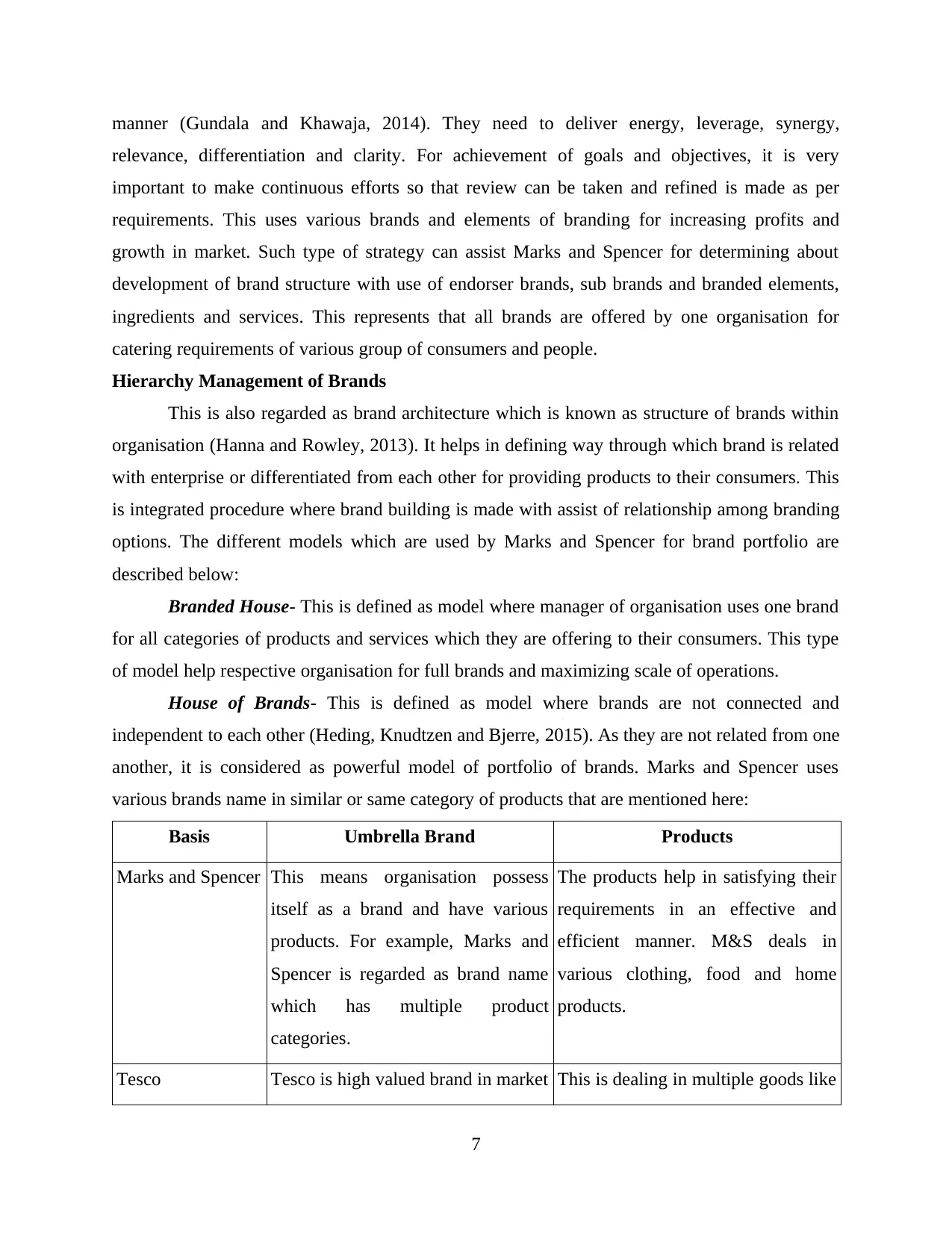
manner (Gundala and Khawaja, 2014). They need to deliver energy, leverage, synergy,
relevance, differentiation and clarity. For achievement of goals and objectives, it is very
important to make continuous efforts so that review can be taken and refined is made as per
requirements. This uses various brands and elements of branding for increasing profits and
growth in market. Such type of strategy can assist Marks and Spencer for determining about
development of brand structure with use of endorser brands, sub brands and branded elements,
ingredients and services. This represents that all brands are offered by one organisation for
catering requirements of various group of consumers and people.
Hierarchy Management of Brands
This is also regarded as brand architecture which is known as structure of brands within
organisation (Hanna and Rowley, 2013). It helps in defining way through which brand is related
with enterprise or differentiated from each other for providing products to their consumers. This
is integrated procedure where brand building is made with assist of relationship among branding
options. The different models which are used by Marks and Spencer for brand portfolio are
described below:
Branded House- This is defined as model where manager of organisation uses one brand
for all categories of products and services which they are offering to their consumers. This type
of model help respective organisation for full brands and maximizing scale of operations.
House of Brands- This is defined as model where brands are not connected and
independent to each other (Heding, Knudtzen and Bjerre, 2015). As they are not related from one
another, it is considered as powerful model of portfolio of brands. Marks and Spencer uses
various brands name in similar or same category of products that are mentioned here:
Basis Umbrella Brand Products
Marks and Spencer This means organisation possess
itself as a brand and have various
products. For example, Marks and
Spencer is regarded as brand name
which has multiple product
categories.
The products help in satisfying their
requirements in an effective and
efficient manner. M&S deals in
various clothing, food and home
products.
Tesco Tesco is high valued brand in market This is dealing in multiple goods like
7
relevance, differentiation and clarity. For achievement of goals and objectives, it is very
important to make continuous efforts so that review can be taken and refined is made as per
requirements. This uses various brands and elements of branding for increasing profits and
growth in market. Such type of strategy can assist Marks and Spencer for determining about
development of brand structure with use of endorser brands, sub brands and branded elements,
ingredients and services. This represents that all brands are offered by one organisation for
catering requirements of various group of consumers and people.
Hierarchy Management of Brands
This is also regarded as brand architecture which is known as structure of brands within
organisation (Hanna and Rowley, 2013). It helps in defining way through which brand is related
with enterprise or differentiated from each other for providing products to their consumers. This
is integrated procedure where brand building is made with assist of relationship among branding
options. The different models which are used by Marks and Spencer for brand portfolio are
described below:
Branded House- This is defined as model where manager of organisation uses one brand
for all categories of products and services which they are offering to their consumers. This type
of model help respective organisation for full brands and maximizing scale of operations.
House of Brands- This is defined as model where brands are not connected and
independent to each other (Heding, Knudtzen and Bjerre, 2015). As they are not related from one
another, it is considered as powerful model of portfolio of brands. Marks and Spencer uses
various brands name in similar or same category of products that are mentioned here:
Basis Umbrella Brand Products
Marks and Spencer This means organisation possess
itself as a brand and have various
products. For example, Marks and
Spencer is regarded as brand name
which has multiple product
categories.
The products help in satisfying their
requirements in an effective and
efficient manner. M&S deals in
various clothing, food and home
products.
Tesco Tesco is high valued brand in market This is dealing in multiple goods like
7
Paraphrase This Document
Need a fresh take? Get an instant paraphrase of this document with our AI Paraphraser
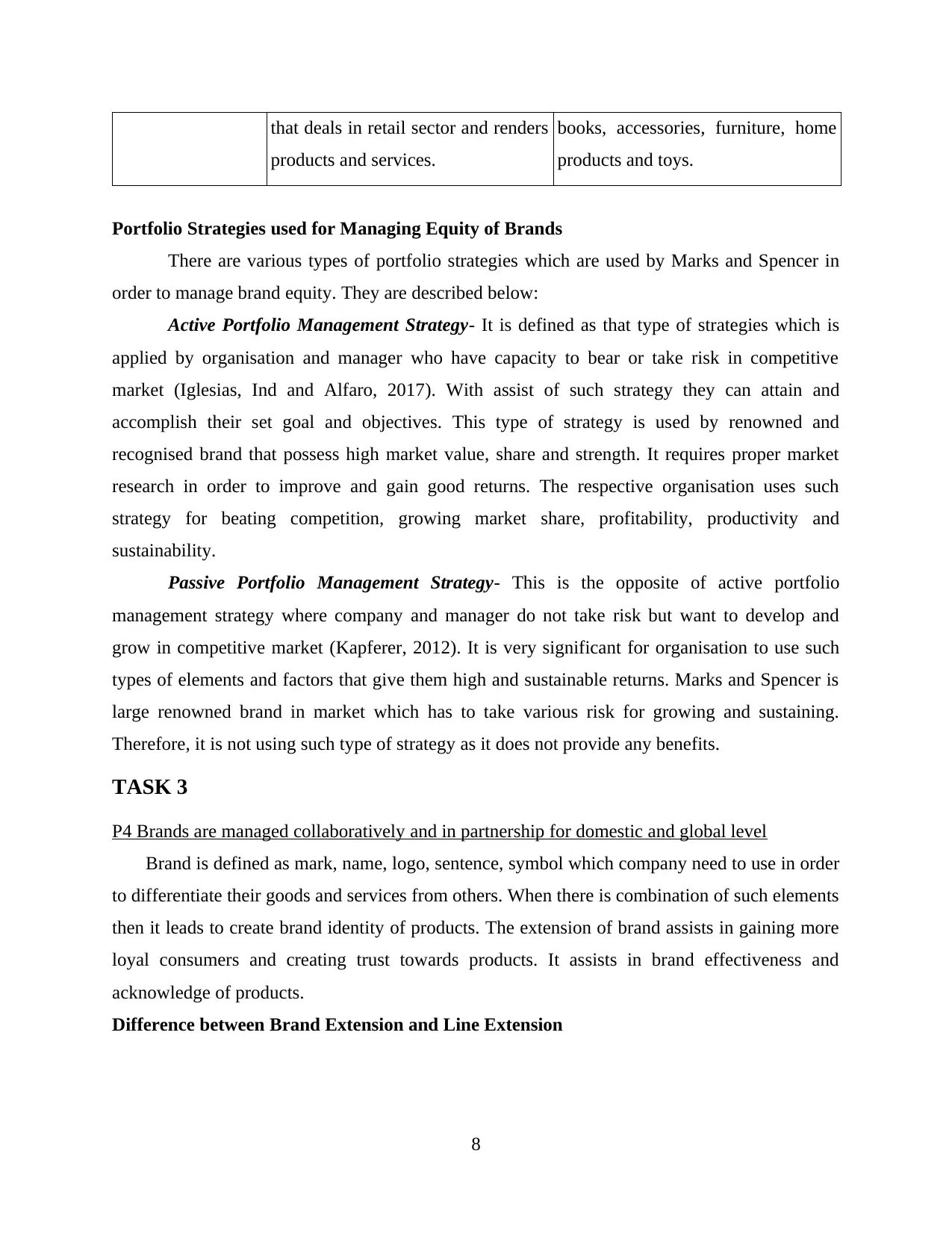
that deals in retail sector and renders
products and services.
books, accessories, furniture, home
products and toys.
Portfolio Strategies used for Managing Equity of Brands
There are various types of portfolio strategies which are used by Marks and Spencer in
order to manage brand equity. They are described below:
Active Portfolio Management Strategy- It is defined as that type of strategies which is
applied by organisation and manager who have capacity to bear or take risk in competitive
market (Iglesias, Ind and Alfaro, 2017). With assist of such strategy they can attain and
accomplish their set goal and objectives. This type of strategy is used by renowned and
recognised brand that possess high market value, share and strength. It requires proper market
research in order to improve and gain good returns. The respective organisation uses such
strategy for beating competition, growing market share, profitability, productivity and
sustainability.
Passive Portfolio Management Strategy- This is the opposite of active portfolio
management strategy where company and manager do not take risk but want to develop and
grow in competitive market (Kapferer, 2012). It is very significant for organisation to use such
types of elements and factors that give them high and sustainable returns. Marks and Spencer is
large renowned brand in market which has to take various risk for growing and sustaining.
Therefore, it is not using such type of strategy as it does not provide any benefits.
TASK 3
P4 Brands are managed collaboratively and in partnership for domestic and global level
Brand is defined as mark, name, logo, sentence, symbol which company need to use in order
to differentiate their goods and services from others. When there is combination of such elements
then it leads to create brand identity of products. The extension of brand assists in gaining more
loyal consumers and creating trust towards products. It assists in brand effectiveness and
acknowledge of products.
Difference between Brand Extension and Line Extension
8
products and services.
books, accessories, furniture, home
products and toys.
Portfolio Strategies used for Managing Equity of Brands
There are various types of portfolio strategies which are used by Marks and Spencer in
order to manage brand equity. They are described below:
Active Portfolio Management Strategy- It is defined as that type of strategies which is
applied by organisation and manager who have capacity to bear or take risk in competitive
market (Iglesias, Ind and Alfaro, 2017). With assist of such strategy they can attain and
accomplish their set goal and objectives. This type of strategy is used by renowned and
recognised brand that possess high market value, share and strength. It requires proper market
research in order to improve and gain good returns. The respective organisation uses such
strategy for beating competition, growing market share, profitability, productivity and
sustainability.
Passive Portfolio Management Strategy- This is the opposite of active portfolio
management strategy where company and manager do not take risk but want to develop and
grow in competitive market (Kapferer, 2012). It is very significant for organisation to use such
types of elements and factors that give them high and sustainable returns. Marks and Spencer is
large renowned brand in market which has to take various risk for growing and sustaining.
Therefore, it is not using such type of strategy as it does not provide any benefits.
TASK 3
P4 Brands are managed collaboratively and in partnership for domestic and global level
Brand is defined as mark, name, logo, sentence, symbol which company need to use in order
to differentiate their goods and services from others. When there is combination of such elements
then it leads to create brand identity of products. The extension of brand assists in gaining more
loyal consumers and creating trust towards products. It assists in brand effectiveness and
acknowledge of products.
Difference between Brand Extension and Line Extension
8
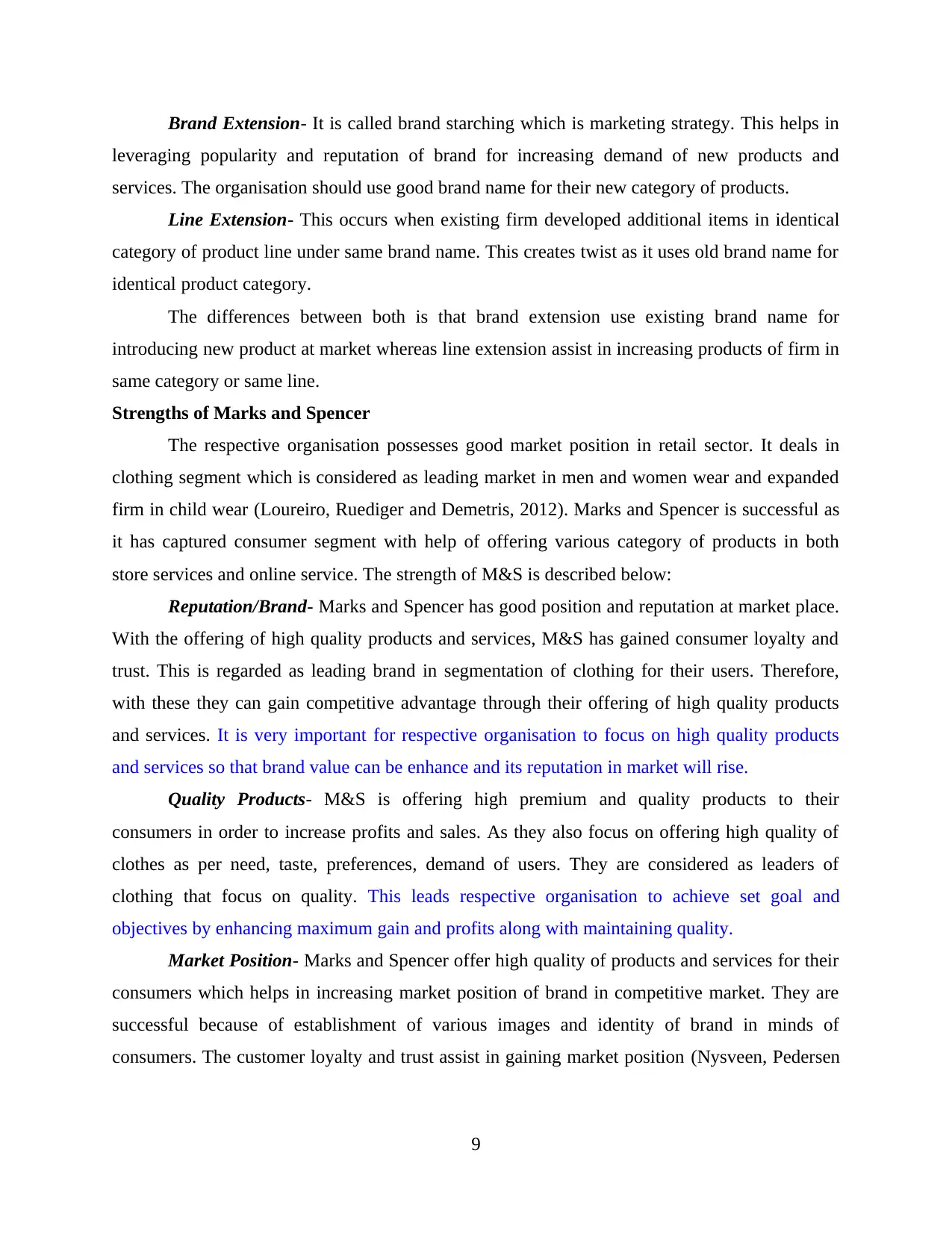
Brand Extension- It is called brand starching which is marketing strategy. This helps in
leveraging popularity and reputation of brand for increasing demand of new products and
services. The organisation should use good brand name for their new category of products.
Line Extension- This occurs when existing firm developed additional items in identical
category of product line under same brand name. This creates twist as it uses old brand name for
identical product category.
The differences between both is that brand extension use existing brand name for
introducing new product at market whereas line extension assist in increasing products of firm in
same category or same line.
Strengths of Marks and Spencer
The respective organisation possesses good market position in retail sector. It deals in
clothing segment which is considered as leading market in men and women wear and expanded
firm in child wear (Loureiro, Ruediger and Demetris, 2012). Marks and Spencer is successful as
it has captured consumer segment with help of offering various category of products in both
store services and online service. The strength of M&S is described below:
Reputation/Brand- Marks and Spencer has good position and reputation at market place.
With the offering of high quality products and services, M&S has gained consumer loyalty and
trust. This is regarded as leading brand in segmentation of clothing for their users. Therefore,
with these they can gain competitive advantage through their offering of high quality products
and services. It is very important for respective organisation to focus on high quality products
and services so that brand value can be enhance and its reputation in market will rise.
Quality Products- M&S is offering high premium and quality products to their
consumers in order to increase profits and sales. As they also focus on offering high quality of
clothes as per need, taste, preferences, demand of users. They are considered as leaders of
clothing that focus on quality. This leads respective organisation to achieve set goal and
objectives by enhancing maximum gain and profits along with maintaining quality.
Market Position- Marks and Spencer offer high quality of products and services for their
consumers which helps in increasing market position of brand in competitive market. They are
successful because of establishment of various images and identity of brand in minds of
consumers. The customer loyalty and trust assist in gaining market position (Nysveen, Pedersen
9
leveraging popularity and reputation of brand for increasing demand of new products and
services. The organisation should use good brand name for their new category of products.
Line Extension- This occurs when existing firm developed additional items in identical
category of product line under same brand name. This creates twist as it uses old brand name for
identical product category.
The differences between both is that brand extension use existing brand name for
introducing new product at market whereas line extension assist in increasing products of firm in
same category or same line.
Strengths of Marks and Spencer
The respective organisation possesses good market position in retail sector. It deals in
clothing segment which is considered as leading market in men and women wear and expanded
firm in child wear (Loureiro, Ruediger and Demetris, 2012). Marks and Spencer is successful as
it has captured consumer segment with help of offering various category of products in both
store services and online service. The strength of M&S is described below:
Reputation/Brand- Marks and Spencer has good position and reputation at market place.
With the offering of high quality products and services, M&S has gained consumer loyalty and
trust. This is regarded as leading brand in segmentation of clothing for their users. Therefore,
with these they can gain competitive advantage through their offering of high quality products
and services. It is very important for respective organisation to focus on high quality products
and services so that brand value can be enhance and its reputation in market will rise.
Quality Products- M&S is offering high premium and quality products to their
consumers in order to increase profits and sales. As they also focus on offering high quality of
clothes as per need, taste, preferences, demand of users. They are considered as leaders of
clothing that focus on quality. This leads respective organisation to achieve set goal and
objectives by enhancing maximum gain and profits along with maintaining quality.
Market Position- Marks and Spencer offer high quality of products and services for their
consumers which helps in increasing market position of brand in competitive market. They are
successful because of establishment of various images and identity of brand in minds of
consumers. The customer loyalty and trust assist in gaining market position (Nysveen, Pedersen
9
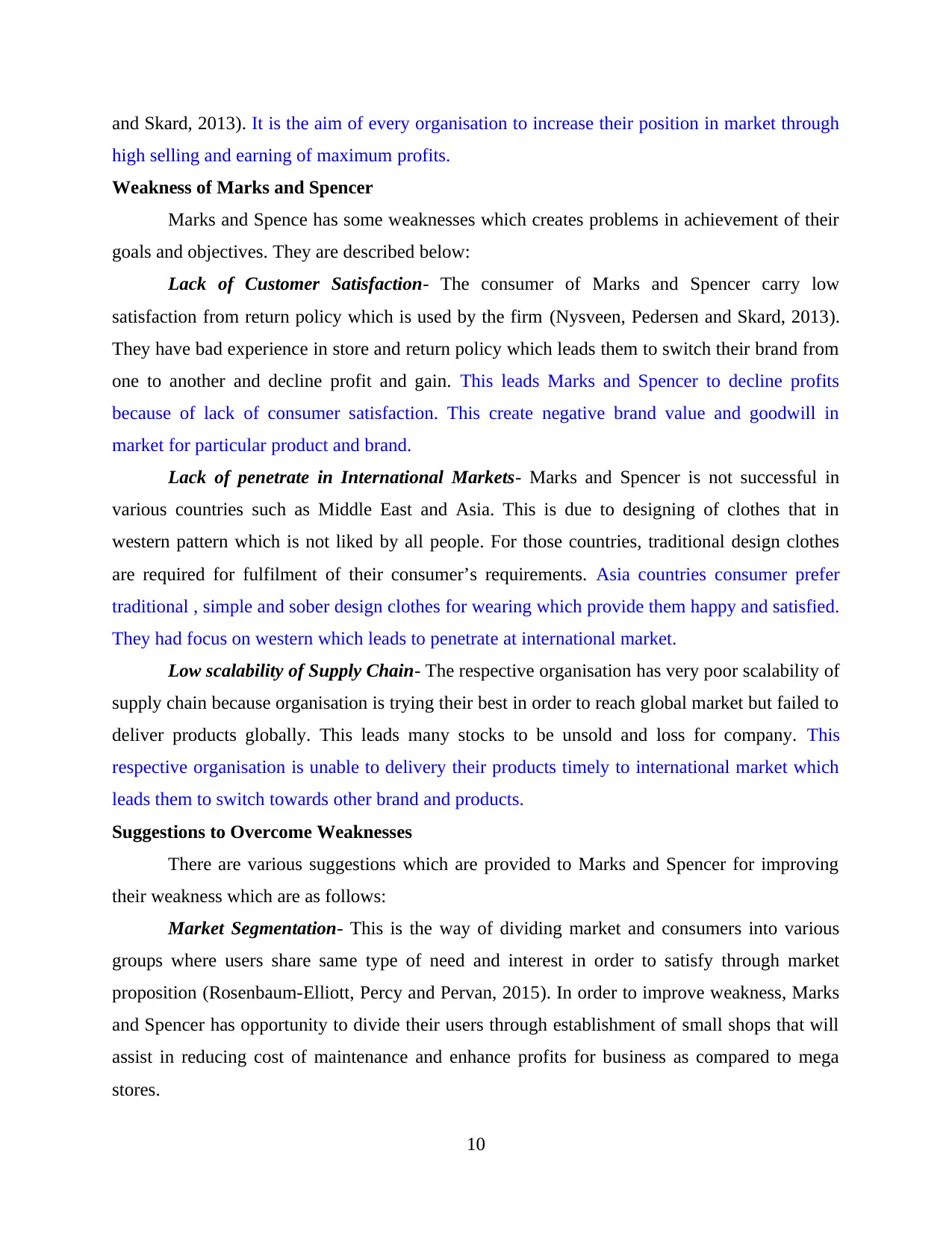
and Skard, 2013). It is the aim of every organisation to increase their position in market through
high selling and earning of maximum profits.
Weakness of Marks and Spencer
Marks and Spence has some weaknesses which creates problems in achievement of their
goals and objectives. They are described below:
Lack of Customer Satisfaction- The consumer of Marks and Spencer carry low
satisfaction from return policy which is used by the firm (Nysveen, Pedersen and Skard, 2013).
They have bad experience in store and return policy which leads them to switch their brand from
one to another and decline profit and gain. This leads Marks and Spencer to decline profits
because of lack of consumer satisfaction. This create negative brand value and goodwill in
market for particular product and brand.
Lack of penetrate in International Markets- Marks and Spencer is not successful in
various countries such as Middle East and Asia. This is due to designing of clothes that in
western pattern which is not liked by all people. For those countries, traditional design clothes
are required for fulfilment of their consumer’s requirements. Asia countries consumer prefer
traditional , simple and sober design clothes for wearing which provide them happy and satisfied.
They had focus on western which leads to penetrate at international market.
Low scalability of Supply Chain- The respective organisation has very poor scalability of
supply chain because organisation is trying their best in order to reach global market but failed to
deliver products globally. This leads many stocks to be unsold and loss for company. This
respective organisation is unable to delivery their products timely to international market which
leads them to switch towards other brand and products.
Suggestions to Overcome Weaknesses
There are various suggestions which are provided to Marks and Spencer for improving
their weakness which are as follows:
Market Segmentation- This is the way of dividing market and consumers into various
groups where users share same type of need and interest in order to satisfy through market
proposition (Rosenbaum-Elliott, Percy and Pervan, 2015). In order to improve weakness, Marks
and Spencer has opportunity to divide their users through establishment of small shops that will
assist in reducing cost of maintenance and enhance profits for business as compared to mega
stores.
10
high selling and earning of maximum profits.
Weakness of Marks and Spencer
Marks and Spence has some weaknesses which creates problems in achievement of their
goals and objectives. They are described below:
Lack of Customer Satisfaction- The consumer of Marks and Spencer carry low
satisfaction from return policy which is used by the firm (Nysveen, Pedersen and Skard, 2013).
They have bad experience in store and return policy which leads them to switch their brand from
one to another and decline profit and gain. This leads Marks and Spencer to decline profits
because of lack of consumer satisfaction. This create negative brand value and goodwill in
market for particular product and brand.
Lack of penetrate in International Markets- Marks and Spencer is not successful in
various countries such as Middle East and Asia. This is due to designing of clothes that in
western pattern which is not liked by all people. For those countries, traditional design clothes
are required for fulfilment of their consumer’s requirements. Asia countries consumer prefer
traditional , simple and sober design clothes for wearing which provide them happy and satisfied.
They had focus on western which leads to penetrate at international market.
Low scalability of Supply Chain- The respective organisation has very poor scalability of
supply chain because organisation is trying their best in order to reach global market but failed to
deliver products globally. This leads many stocks to be unsold and loss for company. This
respective organisation is unable to delivery their products timely to international market which
leads them to switch towards other brand and products.
Suggestions to Overcome Weaknesses
There are various suggestions which are provided to Marks and Spencer for improving
their weakness which are as follows:
Market Segmentation- This is the way of dividing market and consumers into various
groups where users share same type of need and interest in order to satisfy through market
proposition (Rosenbaum-Elliott, Percy and Pervan, 2015). In order to improve weakness, Marks
and Spencer has opportunity to divide their users through establishment of small shops that will
assist in reducing cost of maintenance and enhance profits for business as compared to mega
stores.
10
Secure Best Marks with AI Grader
Need help grading? Try our AI Grader for instant feedback on your assignments.
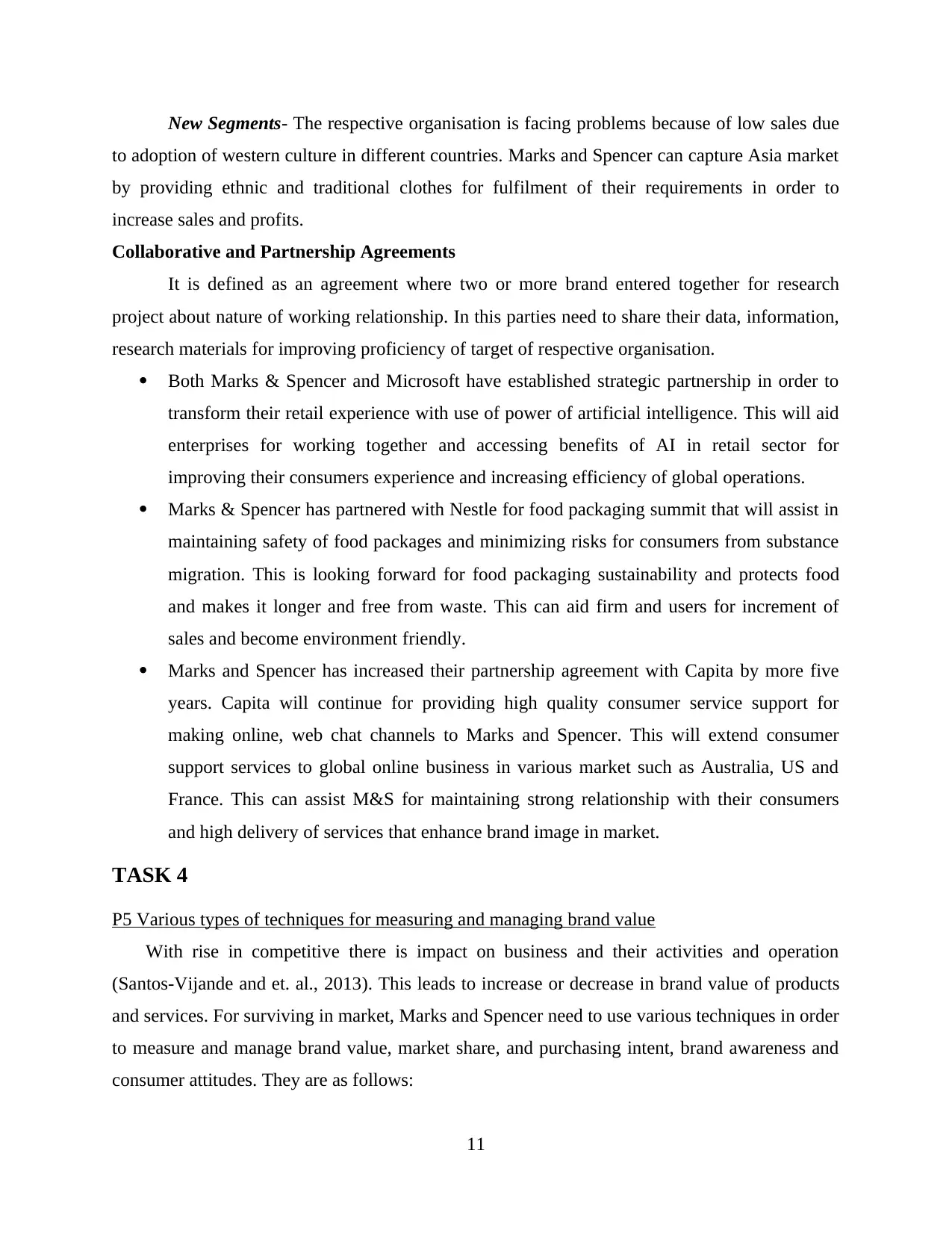
New Segments- The respective organisation is facing problems because of low sales due
to adoption of western culture in different countries. Marks and Spencer can capture Asia market
by providing ethnic and traditional clothes for fulfilment of their requirements in order to
increase sales and profits.
Collaborative and Partnership Agreements
It is defined as an agreement where two or more brand entered together for research
project about nature of working relationship. In this parties need to share their data, information,
research materials for improving proficiency of target of respective organisation.
Both Marks & Spencer and Microsoft have established strategic partnership in order to
transform their retail experience with use of power of artificial intelligence. This will aid
enterprises for working together and accessing benefits of AI in retail sector for
improving their consumers experience and increasing efficiency of global operations.
Marks & Spencer has partnered with Nestle for food packaging summit that will assist in
maintaining safety of food packages and minimizing risks for consumers from substance
migration. This is looking forward for food packaging sustainability and protects food
and makes it longer and free from waste. This can aid firm and users for increment of
sales and become environment friendly.
Marks and Spencer has increased their partnership agreement with Capita by more five
years. Capita will continue for providing high quality consumer service support for
making online, web chat channels to Marks and Spencer. This will extend consumer
support services to global online business in various market such as Australia, US and
France. This can assist M&S for maintaining strong relationship with their consumers
and high delivery of services that enhance brand image in market.
TASK 4
P5 Various types of techniques for measuring and managing brand value
With rise in competitive there is impact on business and their activities and operation
(Santos-Vijande and et. al., 2013). This leads to increase or decrease in brand value of products
and services. For surviving in market, Marks and Spencer need to use various techniques in order
to measure and manage brand value, market share, and purchasing intent, brand awareness and
consumer attitudes. They are as follows:
11
to adoption of western culture in different countries. Marks and Spencer can capture Asia market
by providing ethnic and traditional clothes for fulfilment of their requirements in order to
increase sales and profits.
Collaborative and Partnership Agreements
It is defined as an agreement where two or more brand entered together for research
project about nature of working relationship. In this parties need to share their data, information,
research materials for improving proficiency of target of respective organisation.
Both Marks & Spencer and Microsoft have established strategic partnership in order to
transform their retail experience with use of power of artificial intelligence. This will aid
enterprises for working together and accessing benefits of AI in retail sector for
improving their consumers experience and increasing efficiency of global operations.
Marks & Spencer has partnered with Nestle for food packaging summit that will assist in
maintaining safety of food packages and minimizing risks for consumers from substance
migration. This is looking forward for food packaging sustainability and protects food
and makes it longer and free from waste. This can aid firm and users for increment of
sales and become environment friendly.
Marks and Spencer has increased their partnership agreement with Capita by more five
years. Capita will continue for providing high quality consumer service support for
making online, web chat channels to Marks and Spencer. This will extend consumer
support services to global online business in various market such as Australia, US and
France. This can assist M&S for maintaining strong relationship with their consumers
and high delivery of services that enhance brand image in market.
TASK 4
P5 Various types of techniques for measuring and managing brand value
With rise in competitive there is impact on business and their activities and operation
(Santos-Vijande and et. al., 2013). This leads to increase or decrease in brand value of products
and services. For surviving in market, Marks and Spencer need to use various techniques in order
to measure and manage brand value, market share, and purchasing intent, brand awareness and
consumer attitudes. They are as follows:
11
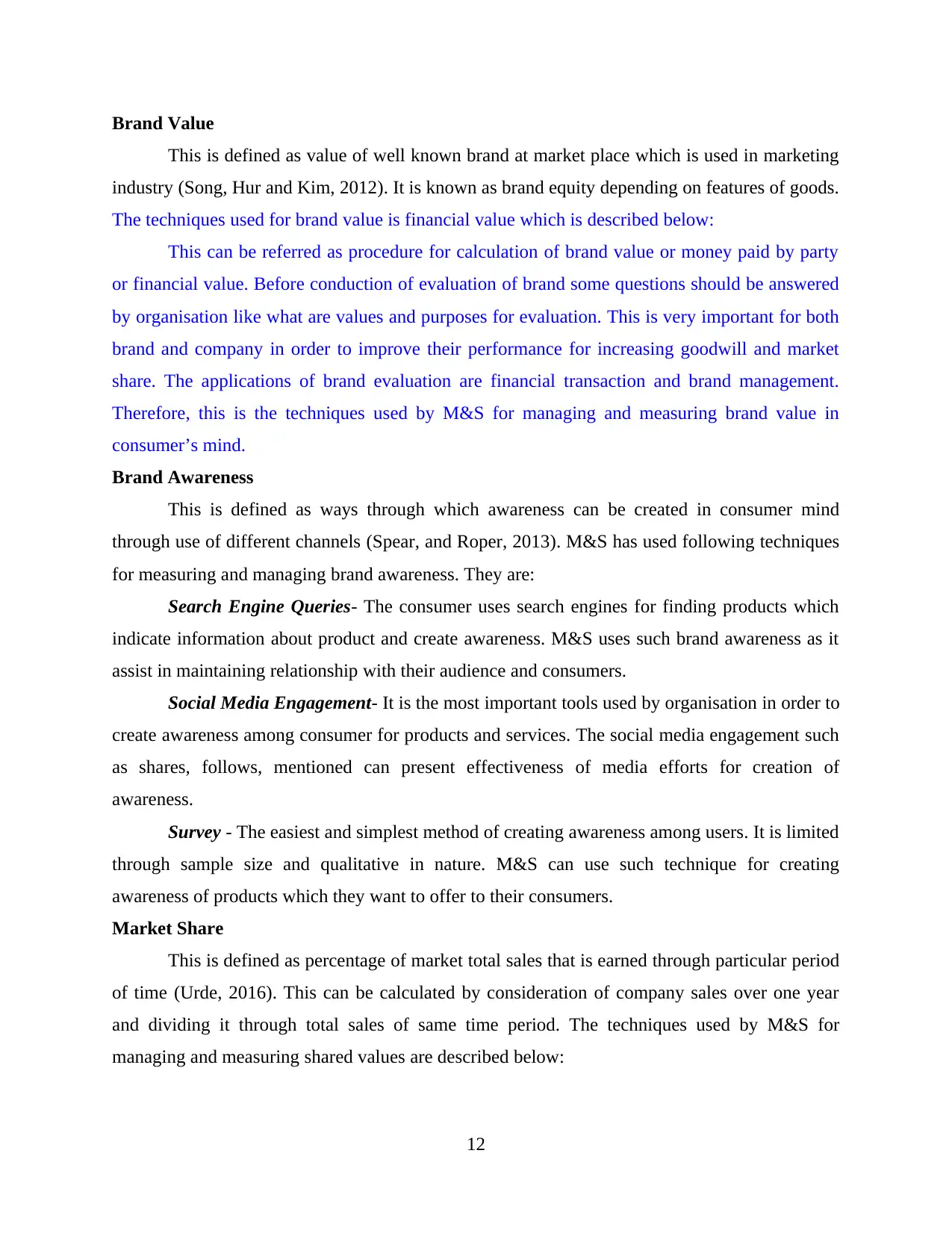
Brand Value
This is defined as value of well known brand at market place which is used in marketing
industry (Song, Hur and Kim, 2012). It is known as brand equity depending on features of goods.
The techniques used for brand value is financial value which is described below:
This can be referred as procedure for calculation of brand value or money paid by party
or financial value. Before conduction of evaluation of brand some questions should be answered
by organisation like what are values and purposes for evaluation. This is very important for both
brand and company in order to improve their performance for increasing goodwill and market
share. The applications of brand evaluation are financial transaction and brand management.
Therefore, this is the techniques used by M&S for managing and measuring brand value in
consumer’s mind.
Brand Awareness
This is defined as ways through which awareness can be created in consumer mind
through use of different channels (Spear, and Roper, 2013). M&S has used following techniques
for measuring and managing brand awareness. They are:
Search Engine Queries- The consumer uses search engines for finding products which
indicate information about product and create awareness. M&S uses such brand awareness as it
assist in maintaining relationship with their audience and consumers.
Social Media Engagement- It is the most important tools used by organisation in order to
create awareness among consumer for products and services. The social media engagement such
as shares, follows, mentioned can present effectiveness of media efforts for creation of
awareness.
Survey - The easiest and simplest method of creating awareness among users. It is limited
through sample size and qualitative in nature. M&S can use such technique for creating
awareness of products which they want to offer to their consumers.
Market Share
This is defined as percentage of market total sales that is earned through particular period
of time (Urde, 2016). This can be calculated by consideration of company sales over one year
and dividing it through total sales of same time period. The techniques used by M&S for
managing and measuring shared values are described below:
12
This is defined as value of well known brand at market place which is used in marketing
industry (Song, Hur and Kim, 2012). It is known as brand equity depending on features of goods.
The techniques used for brand value is financial value which is described below:
This can be referred as procedure for calculation of brand value or money paid by party
or financial value. Before conduction of evaluation of brand some questions should be answered
by organisation like what are values and purposes for evaluation. This is very important for both
brand and company in order to improve their performance for increasing goodwill and market
share. The applications of brand evaluation are financial transaction and brand management.
Therefore, this is the techniques used by M&S for managing and measuring brand value in
consumer’s mind.
Brand Awareness
This is defined as ways through which awareness can be created in consumer mind
through use of different channels (Spear, and Roper, 2013). M&S has used following techniques
for measuring and managing brand awareness. They are:
Search Engine Queries- The consumer uses search engines for finding products which
indicate information about product and create awareness. M&S uses such brand awareness as it
assist in maintaining relationship with their audience and consumers.
Social Media Engagement- It is the most important tools used by organisation in order to
create awareness among consumer for products and services. The social media engagement such
as shares, follows, mentioned can present effectiveness of media efforts for creation of
awareness.
Survey - The easiest and simplest method of creating awareness among users. It is limited
through sample size and qualitative in nature. M&S can use such technique for creating
awareness of products which they want to offer to their consumers.
Market Share
This is defined as percentage of market total sales that is earned through particular period
of time (Urde, 2016). This can be calculated by consideration of company sales over one year
and dividing it through total sales of same time period. The techniques used by M&S for
managing and measuring shared values are described below:
12
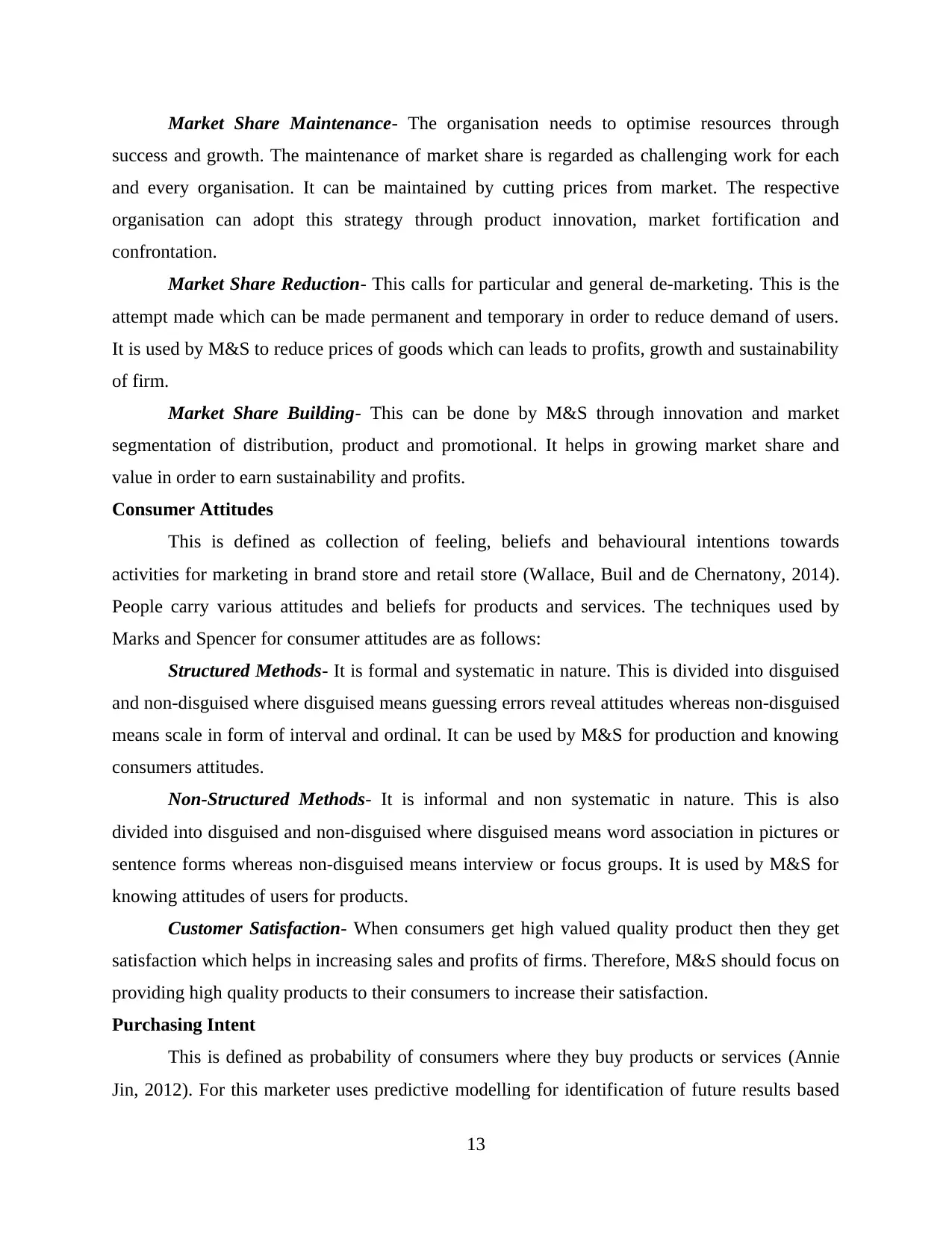
Market Share Maintenance- The organisation needs to optimise resources through
success and growth. The maintenance of market share is regarded as challenging work for each
and every organisation. It can be maintained by cutting prices from market. The respective
organisation can adopt this strategy through product innovation, market fortification and
confrontation.
Market Share Reduction- This calls for particular and general de-marketing. This is the
attempt made which can be made permanent and temporary in order to reduce demand of users.
It is used by M&S to reduce prices of goods which can leads to profits, growth and sustainability
of firm.
Market Share Building- This can be done by M&S through innovation and market
segmentation of distribution, product and promotional. It helps in growing market share and
value in order to earn sustainability and profits.
Consumer Attitudes
This is defined as collection of feeling, beliefs and behavioural intentions towards
activities for marketing in brand store and retail store (Wallace, Buil and de Chernatony, 2014).
People carry various attitudes and beliefs for products and services. The techniques used by
Marks and Spencer for consumer attitudes are as follows:
Structured Methods- It is formal and systematic in nature. This is divided into disguised
and non-disguised where disguised means guessing errors reveal attitudes whereas non-disguised
means scale in form of interval and ordinal. It can be used by M&S for production and knowing
consumers attitudes.
Non-Structured Methods- It is informal and non systematic in nature. This is also
divided into disguised and non-disguised where disguised means word association in pictures or
sentence forms whereas non-disguised means interview or focus groups. It is used by M&S for
knowing attitudes of users for products.
Customer Satisfaction- When consumers get high valued quality product then they get
satisfaction which helps in increasing sales and profits of firms. Therefore, M&S should focus on
providing high quality products to their consumers to increase their satisfaction.
Purchasing Intent
This is defined as probability of consumers where they buy products or services (Annie
Jin, 2012). For this marketer uses predictive modelling for identification of future results based
13
success and growth. The maintenance of market share is regarded as challenging work for each
and every organisation. It can be maintained by cutting prices from market. The respective
organisation can adopt this strategy through product innovation, market fortification and
confrontation.
Market Share Reduction- This calls for particular and general de-marketing. This is the
attempt made which can be made permanent and temporary in order to reduce demand of users.
It is used by M&S to reduce prices of goods which can leads to profits, growth and sustainability
of firm.
Market Share Building- This can be done by M&S through innovation and market
segmentation of distribution, product and promotional. It helps in growing market share and
value in order to earn sustainability and profits.
Consumer Attitudes
This is defined as collection of feeling, beliefs and behavioural intentions towards
activities for marketing in brand store and retail store (Wallace, Buil and de Chernatony, 2014).
People carry various attitudes and beliefs for products and services. The techniques used by
Marks and Spencer for consumer attitudes are as follows:
Structured Methods- It is formal and systematic in nature. This is divided into disguised
and non-disguised where disguised means guessing errors reveal attitudes whereas non-disguised
means scale in form of interval and ordinal. It can be used by M&S for production and knowing
consumers attitudes.
Non-Structured Methods- It is informal and non systematic in nature. This is also
divided into disguised and non-disguised where disguised means word association in pictures or
sentence forms whereas non-disguised means interview or focus groups. It is used by M&S for
knowing attitudes of users for products.
Customer Satisfaction- When consumers get high valued quality product then they get
satisfaction which helps in increasing sales and profits of firms. Therefore, M&S should focus on
providing high quality products to their consumers to increase their satisfaction.
Purchasing Intent
This is defined as probability of consumers where they buy products or services (Annie
Jin, 2012). For this marketer uses predictive modelling for identification of future results based
13
Paraphrase This Document
Need a fresh take? Get an instant paraphrase of this document with our AI Paraphraser
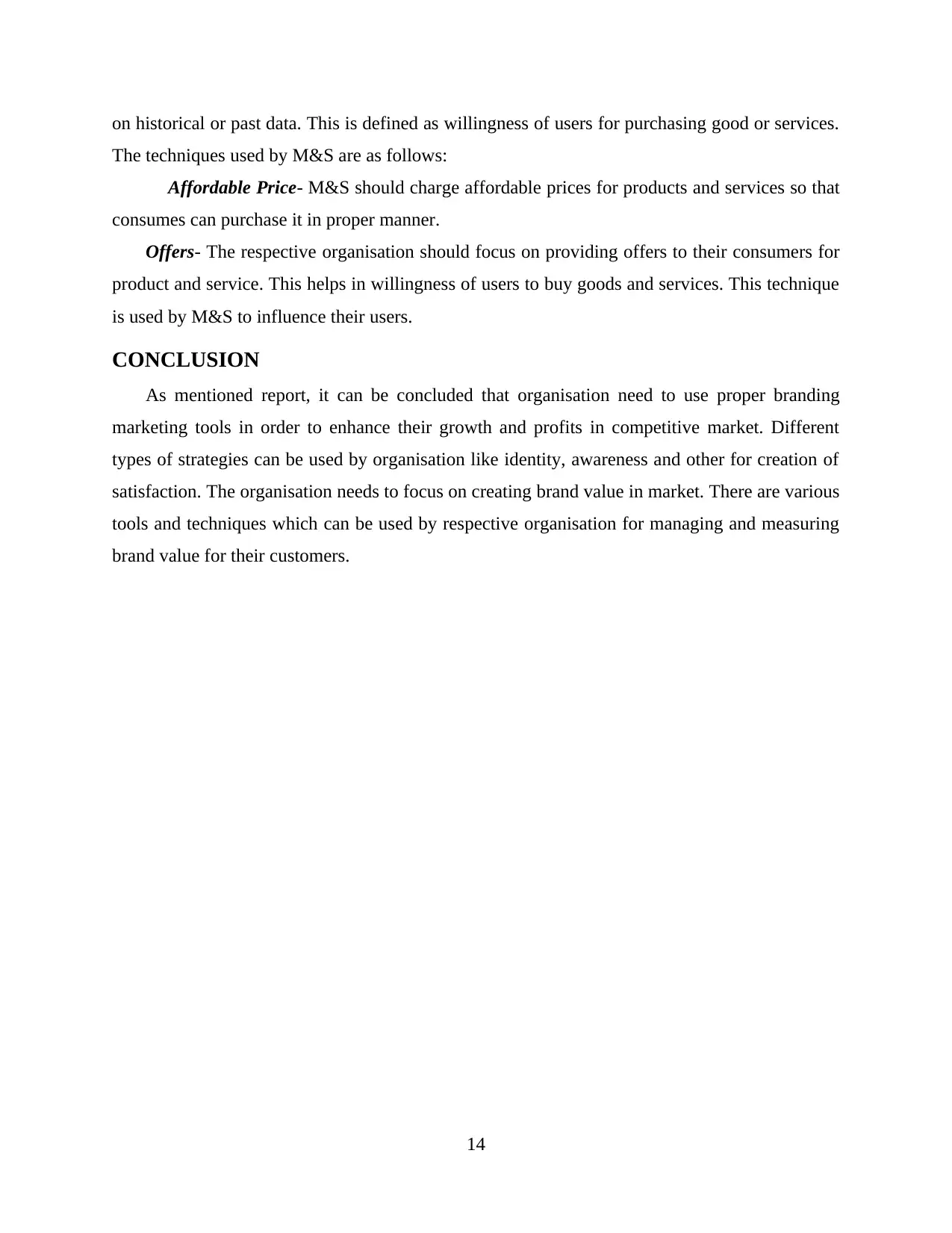
on historical or past data. This is defined as willingness of users for purchasing good or services.
The techniques used by M&S are as follows:
Affordable Price- M&S should charge affordable prices for products and services so that
consumes can purchase it in proper manner.
Offers- The respective organisation should focus on providing offers to their consumers for
product and service. This helps in willingness of users to buy goods and services. This technique
is used by M&S to influence their users.
CONCLUSION
As mentioned report, it can be concluded that organisation need to use proper branding
marketing tools in order to enhance their growth and profits in competitive market. Different
types of strategies can be used by organisation like identity, awareness and other for creation of
satisfaction. The organisation needs to focus on creating brand value in market. There are various
tools and techniques which can be used by respective organisation for managing and measuring
brand value for their customers.
14
The techniques used by M&S are as follows:
Affordable Price- M&S should charge affordable prices for products and services so that
consumes can purchase it in proper manner.
Offers- The respective organisation should focus on providing offers to their consumers for
product and service. This helps in willingness of users to buy goods and services. This technique
is used by M&S to influence their users.
CONCLUSION
As mentioned report, it can be concluded that organisation need to use proper branding
marketing tools in order to enhance their growth and profits in competitive market. Different
types of strategies can be used by organisation like identity, awareness and other for creation of
satisfaction. The organisation needs to focus on creating brand value in market. There are various
tools and techniques which can be used by respective organisation for managing and measuring
brand value for their customers.
14
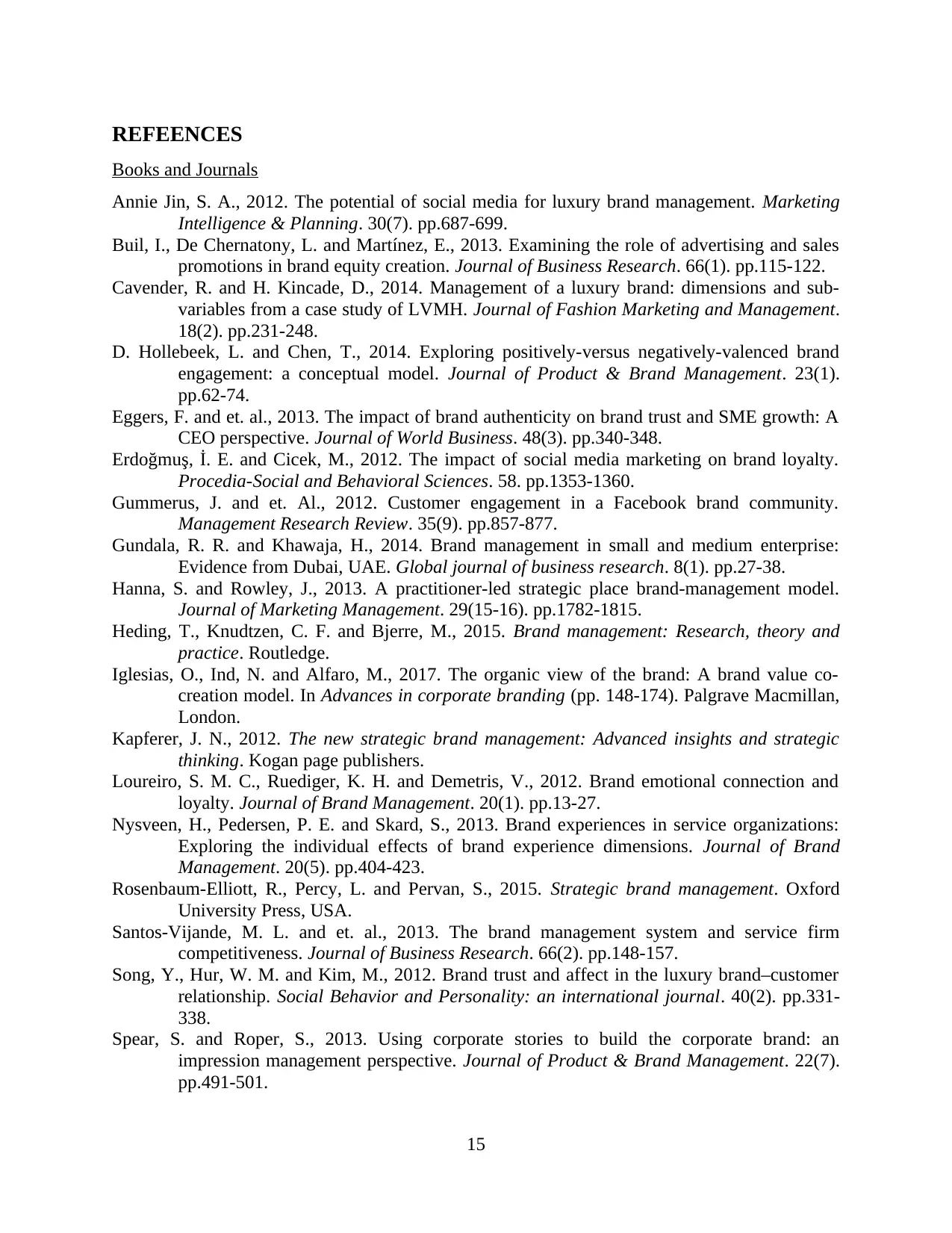
REFEENCES
Books and Journals
Annie Jin, S. A., 2012. The potential of social media for luxury brand management. Marketing
Intelligence & Planning. 30(7). pp.687-699.
Buil, I., De Chernatony, L. and Martínez, E., 2013. Examining the role of advertising and sales
promotions in brand equity creation. Journal of Business Research. 66(1). pp.115-122.
Cavender, R. and H. Kincade, D., 2014. Management of a luxury brand: dimensions and sub-
variables from a case study of LVMH. Journal of Fashion Marketing and Management.
18(2). pp.231-248.
D. Hollebeek, L. and Chen, T., 2014. Exploring positively-versus negatively-valenced brand
engagement: a conceptual model. Journal of Product & Brand Management. 23(1).
pp.62-74.
Eggers, F. and et. al., 2013. The impact of brand authenticity on brand trust and SME growth: A
CEO perspective. Journal of World Business. 48(3). pp.340-348.
Erdoğmuş, İ. E. and Cicek, M., 2012. The impact of social media marketing on brand loyalty.
Procedia-Social and Behavioral Sciences. 58. pp.1353-1360.
Gummerus, J. and et. Al., 2012. Customer engagement in a Facebook brand community.
Management Research Review. 35(9). pp.857-877.
Gundala, R. R. and Khawaja, H., 2014. Brand management in small and medium enterprise:
Evidence from Dubai, UAE. Global journal of business research. 8(1). pp.27-38.
Hanna, S. and Rowley, J., 2013. A practitioner-led strategic place brand-management model.
Journal of Marketing Management. 29(15-16). pp.1782-1815.
Heding, T., Knudtzen, C. F. and Bjerre, M., 2015. Brand management: Research, theory and
practice. Routledge.
Iglesias, O., Ind, N. and Alfaro, M., 2017. The organic view of the brand: A brand value co-
creation model. In Advances in corporate branding (pp. 148-174). Palgrave Macmillan,
London.
Kapferer, J. N., 2012. The new strategic brand management: Advanced insights and strategic
thinking. Kogan page publishers.
Loureiro, S. M. C., Ruediger, K. H. and Demetris, V., 2012. Brand emotional connection and
loyalty. Journal of Brand Management. 20(1). pp.13-27.
Nysveen, H., Pedersen, P. E. and Skard, S., 2013. Brand experiences in service organizations:
Exploring the individual effects of brand experience dimensions. Journal of Brand
Management. 20(5). pp.404-423.
Rosenbaum-Elliott, R., Percy, L. and Pervan, S., 2015. Strategic brand management. Oxford
University Press, USA.
Santos-Vijande, M. L. and et. al., 2013. The brand management system and service firm
competitiveness. Journal of Business Research. 66(2). pp.148-157.
Song, Y., Hur, W. M. and Kim, M., 2012. Brand trust and affect in the luxury brand–customer
relationship. Social Behavior and Personality: an international journal. 40(2). pp.331-
338.
Spear, S. and Roper, S., 2013. Using corporate stories to build the corporate brand: an
impression management perspective. Journal of Product & Brand Management. 22(7).
pp.491-501.
15
Books and Journals
Annie Jin, S. A., 2012. The potential of social media for luxury brand management. Marketing
Intelligence & Planning. 30(7). pp.687-699.
Buil, I., De Chernatony, L. and Martínez, E., 2013. Examining the role of advertising and sales
promotions in brand equity creation. Journal of Business Research. 66(1). pp.115-122.
Cavender, R. and H. Kincade, D., 2014. Management of a luxury brand: dimensions and sub-
variables from a case study of LVMH. Journal of Fashion Marketing and Management.
18(2). pp.231-248.
D. Hollebeek, L. and Chen, T., 2014. Exploring positively-versus negatively-valenced brand
engagement: a conceptual model. Journal of Product & Brand Management. 23(1).
pp.62-74.
Eggers, F. and et. al., 2013. The impact of brand authenticity on brand trust and SME growth: A
CEO perspective. Journal of World Business. 48(3). pp.340-348.
Erdoğmuş, İ. E. and Cicek, M., 2012. The impact of social media marketing on brand loyalty.
Procedia-Social and Behavioral Sciences. 58. pp.1353-1360.
Gummerus, J. and et. Al., 2012. Customer engagement in a Facebook brand community.
Management Research Review. 35(9). pp.857-877.
Gundala, R. R. and Khawaja, H., 2014. Brand management in small and medium enterprise:
Evidence from Dubai, UAE. Global journal of business research. 8(1). pp.27-38.
Hanna, S. and Rowley, J., 2013. A practitioner-led strategic place brand-management model.
Journal of Marketing Management. 29(15-16). pp.1782-1815.
Heding, T., Knudtzen, C. F. and Bjerre, M., 2015. Brand management: Research, theory and
practice. Routledge.
Iglesias, O., Ind, N. and Alfaro, M., 2017. The organic view of the brand: A brand value co-
creation model. In Advances in corporate branding (pp. 148-174). Palgrave Macmillan,
London.
Kapferer, J. N., 2012. The new strategic brand management: Advanced insights and strategic
thinking. Kogan page publishers.
Loureiro, S. M. C., Ruediger, K. H. and Demetris, V., 2012. Brand emotional connection and
loyalty. Journal of Brand Management. 20(1). pp.13-27.
Nysveen, H., Pedersen, P. E. and Skard, S., 2013. Brand experiences in service organizations:
Exploring the individual effects of brand experience dimensions. Journal of Brand
Management. 20(5). pp.404-423.
Rosenbaum-Elliott, R., Percy, L. and Pervan, S., 2015. Strategic brand management. Oxford
University Press, USA.
Santos-Vijande, M. L. and et. al., 2013. The brand management system and service firm
competitiveness. Journal of Business Research. 66(2). pp.148-157.
Song, Y., Hur, W. M. and Kim, M., 2012. Brand trust and affect in the luxury brand–customer
relationship. Social Behavior and Personality: an international journal. 40(2). pp.331-
338.
Spear, S. and Roper, S., 2013. Using corporate stories to build the corporate brand: an
impression management perspective. Journal of Product & Brand Management. 22(7).
pp.491-501.
15
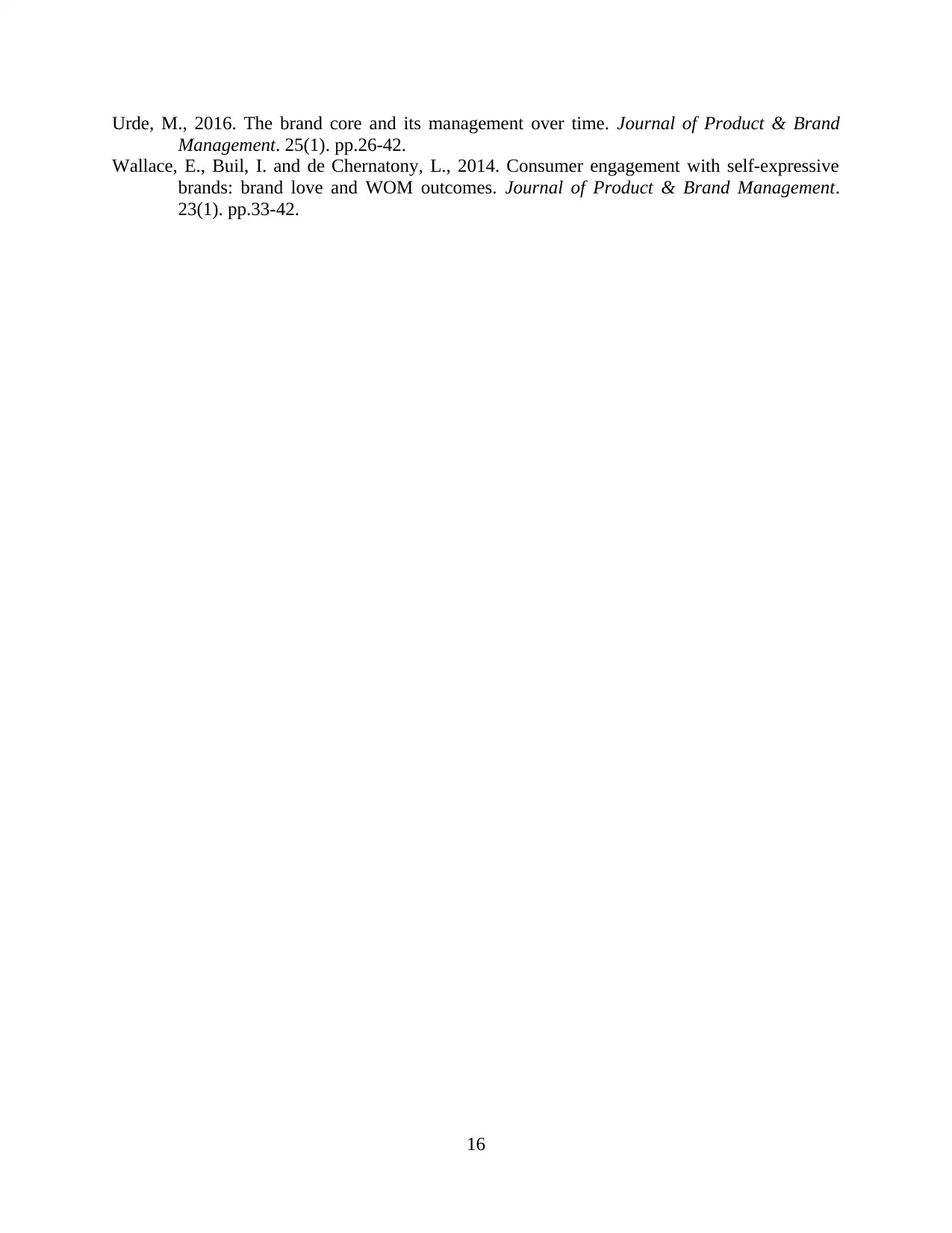
Urde, M., 2016. The brand core and its management over time. Journal of Product & Brand
Management. 25(1). pp.26-42.
Wallace, E., Buil, I. and de Chernatony, L., 2014. Consumer engagement with self-expressive
brands: brand love and WOM outcomes. Journal of Product & Brand Management.
23(1). pp.33-42.
16
Management. 25(1). pp.26-42.
Wallace, E., Buil, I. and de Chernatony, L., 2014. Consumer engagement with self-expressive
brands: brand love and WOM outcomes. Journal of Product & Brand Management.
23(1). pp.33-42.
16
1 out of 16
Related Documents
Your All-in-One AI-Powered Toolkit for Academic Success.
+13062052269
info@desklib.com
Available 24*7 on WhatsApp / Email
![[object Object]](/_next/static/media/star-bottom.7253800d.svg)
Unlock your academic potential
© 2024 | Zucol Services PVT LTD | All rights reserved.





